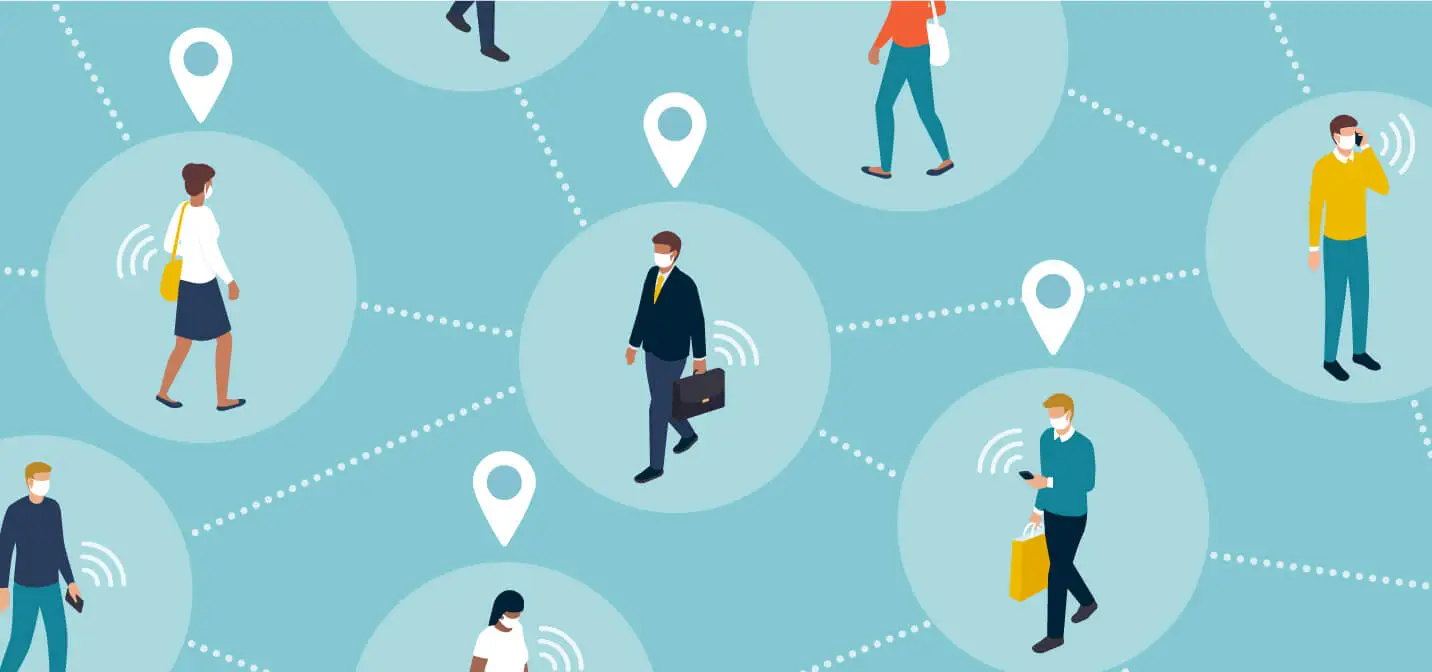Location-based marketing has become one of the most important advertising strategies in the marketing world. It’s based on location analytics — a type of data analytics that uses data related to geographical locations and human movement data. Huge amounts of geographical data are generated through GPS and opted-in data from mobile devices, which marketing and operations data leaders can use to inform their business decisions, and target and understand their audiences better.
What is Location Analysis?
In recent years, location analysis or location intelligence has become a game-changer in every aspect of business in almost every field, from real estate to manufacturing. It can be used to uniform multiple business decisions, from selecting the next site location of a store or where to place billboard advertisements to reach wider audiences. The stakes can be high. For example, when it comes to site selection, a wrong decision can lead to considerable losses due to multiple factors. That’s where location analysis comes into the picture. It helps businesses find the ideal location for opening their new offices, store locations, or manufacturing units by analysing audience demographics, psychographics, brand affinities, trade areas, pathing, and other important factors. Location analysis also accelerates the decision-making process for organizations. Location analysis involves five important areas of analysis — Demographic, Trade Area, Competitive, Traffic, and Site Economics.
Analytics converts data into useful information by detecting and demonstrating trends, patterns, and relationships in charts, graphs, and tables. The final output may be statistical reports used by different departments of an organization, such as business intelligence, customer relationship management, resource management, and asset management.
In recent years, organizations have realized the benefits of using human movement data and have begun mapping it to consumer insights. The science and practice of geographical intelligence and mapping is known as location analytics. It is based on thematic mapping, spatial analysis, and studying human movement over time across different locations.
Location data or human movement data is readily available to everyone these days, and it is used to inform both marketing and operational decisions by organizations across industries. Human movement data has allowed organizations to make better business decisions on everything from selecting their next store locations and optimizing ad targeting, to understanding shifts in consumer behavior. These and many other use cases have made location analysis one of the important aspects of business analytics.
How Can Businesses Use Location Analytics?
Businesses can use location analytics in many different ways. Businesses across an array of industries can and should be using location analytics to improve business processes. Whether you work in tourism, retail, restaurants, or commercial real estate, location analytics and insights can benefit your business in multiple ways.
Here are 5 ways to use location analysis.
1. Understand Your Customers Better: Understanding your customers better is essential for every business. A business that deeply understands its customers is more likely to attract and retain them in the long term. Location analytics helps marketers by providing insights on the total population, age, average income, education, occupation, and brand affinities of the particular area. It can also inform marketers on consumer behavior like paths to purchase, dwell time, frequency of visits, and where audiences go after visiting a location. These insights are used to inform marketing and advertising strategy, optimize messaging and target the right audiences.
2. Enhance Customer Experience: Businesses can enhance their customers’ experience and journey by offering a more personalized experience. With insights gained from location analytics, brands can understand customer needs and customize their messaging and offers for both existing and prospective customers. For example, a retail store selling basketball shoes can serve a geo-fenced ad to prospects in the vicinity, who have previously visited the store’s website and searched for basketball shoes.
3. Ensure Smooth Operations: Location analytics can help identify areas/locations where potential customers stay, which can be used to make better decisions on selecting locations for stores, warehouses, or distribution centers. While more people have been preferring to shop online, they also want their items delivered in the shortest time possible. Location analytics can help operational leaders bring network optimization and site selection together to ensure brands can offer short delivery times. Heat maps show traffic patterns of customers on a real-time, hourly, and daily basis and these insights can help businesses identify the perfect location for a pop-up store or select their next store location.
4. Measure Competitor’s Performance: You can measure your competitor’s performance by observing footfall to their store or understanding their audience demographics, dwell time, and frequency of visits. One of the most powerful capabilities of human movement data is competitor insights. By simply defining the boundaries of what you want to study on a map, you can get data on any location. That includes your business as well as your competitors. While you’re able to learn more about your own customers, it is also helpful to have these insights on your competitor. See how your visitors compare to theirs, or how your location performs in comparison to theirs. Use this intelligence to better understand and attract your ideal customer base. With human movement data, you can track how you’re doing compared to your competitors on:
Market share
Competitive visitations
Market level insights
Trade areas
Human movement data provides the quickest and easiest way to perform competitive analysis, and take action on it.
5. Optimize Marketing Campaigns: Location analytics helps in improving marketing strategies by using the geographical area to target the right audiences, and offer relevant offers and discounts in real-time by identifying their needs. Here are just a few examples of how location analytics can be used in marketing campaigns:
Target your best shoppers with digital billboard ads based on location.
Create a segment of store visitors and target a lookalike audience of those shoppers.
Target lost customers who’ve visited competitor stores with win-back offers via email.
Use human movement data to recognize people who visited your store but did not make a purchase, and target them with additional offers on digital channels.
Supplement your 1st party data with human movement data to understand where else they shop and visit, and use that intel for custom targeting.
What is location based advertising?
Location-based advertising is a marketing strategy that uses location data to optimize and enhance the ads advertisers target customers with. This data does not include any personally identifiable data and this is done in a privacy-safe manner, in compliance with privacy laws such as GDPR and CCPA. It allows marketers to target consumers with promotions at an individual level based on their location data. It has proven to be effective across customer lifecycles, from awareness to loyalty and experience. It improves the user experience and focuses on specific customer segments to send targeted offers by understanding their preferences, needs, and wants.
How location-based advertising works?
Location-based advertising uses different techniques and working principles, depending on a marketers’ needs. Location data is usually collected from mobile phones and other devices, where sensors are installed to collect and understand this data. These sensors range from beacons to geofences to geotargeting. Using a combination of these sensors allows for more precise accuracy and scalability.
Here are some popular location-based marketing techniques used by marketers to increase their sales and engagement.
Geotargeting: Geotargeting means showing different advertisements to different customers based on their geographic location. Advertisers can set a specific location or area where they want their ads to show. So, if users are in those locations, then those set ads will appear on their devices. It narrows down the customer base and cuts down unnecessary marketing costs.
Geofencing: A virtual perimeter known as a geofence is built around a specific location or area. When a particular mobile device or RFID (Radio Frequency Identification) tag enters this virtual perimeter, it triggers targeted marketing and advertising actions such as a push notifications. Usage of RFID, Wi-Fi, GPS, or cellular data can help businesses better communicate with their potential customers.
As soon as you enter the geofence, it triggers geofencing mechanisms, and customers can be targeted on their mobile phones with a text message, push notification, or display ads.
Geo-conquesting: Geo-conquesting is the practice of attracting customers from your competitors’ businesses by using location-based advertising and marketing. Ads are targeted when your potential customers are in the vicinity of your competitors’ locations. They will receive push notifications or ads about your company’s products when they visit a competitor’s store location. Many businesses use this to offer competitive discounts to their customers so that they choose them over their competitors.
For example, if you are a pizza shop owner, you can reach and engage with customers near your competitor’s location and offer them better discounts. It is an effective way to persuade customers to choose your brand over a competitor’s that they were considering. You can also use location history to reach the customers who had previously visited your competitors.
Beacon Marketing: Beacon Marketing is a location-based advertising technique that uses physical devices known as beacons to send signals to mobile devices through Bluetooth signals that are in the vicinity of their premises. It helps businesses offer more personalized experiences to their customers.
Advertisers can integrate beacons with third-party location services to equip them with more information on customers’ buying behaviors. It helps to offer recommendations based on your past buying history and offers targeted deals and rewards through push notifications.
For example, for a retail store, beacons can help marketers identify the aisles that attract the most crowds or identify aisles that don’t perform as well as others. Beacons can also be placed near clothing racks or other specific merchandise to send nearby shoppers mobile notifications with custom offers.
However, beacons have some limitations – location tracking, push notifications, and Bluetooth must be on, and they can target only a small audience. Therefore, it is recommended to use beacons for reaching out to your loyal customers, collecting in-store behavioral data, and for event promotions.
Blueprints location-based marketing:Blueprint location-based marketing is the most complicated and sophisticated form of geolocation marketing. Blueprints create geographic boundaries around locations or points of interest. It combines users’ location and behavioral data to filter to the right target audience and achieve better results.
Benefits of Using Location-Based Advertising
Location-based advertising benefits both customers and advertisers. Through location-based advertising, marketers can deliver more targeted and relevant ads to build relationships with their customers and grow awareness. It improves the overall user experience, and targeted ads and messaging and prevent the unnecessary waste of resources and time.
The customer gets more personalized ads that match their needs or interests instead of random, irrelevant content. They get real-time information about discounts, promotions, and offers on products or services they have the intention to buy.
There are several benefits of using location-based advertising, including:
Maximum relevance with location targeting:
You can target customers on the basis of their location by tempting them with offers and discounts nearby. Not only that, you can target customers with specific demographics based on socioeconomic geodata available. For example, marketers can set up a geofence around colleges, universities, and bars if they want to target a yound ads based on location.
Customized targeting and messaging:
Improved customer experience and engagement:
Ability to capture multiple markets:
Customer acquisition:
Marketers can target competitors' customers and encourage them to visit their store by offering them enticing offers when they are in the vicinity of the competitor’s store.
How to Get Started with Location-Based Advertising?
You can get started with location-based advertising campaigns anytime. However, it is important to do some research and create a well-planned strategy first. Consider the following before getting started with location-based marketing so that you can make the most out of it.
Step 1: Research your potential customers: Use location data to understand your customer better before launching any location-based marketing campaign. Create a detailed location-based advertising strategy based on customers’ needs. Ensure the following things are addressed through your marketing strategy:
Understand the needs and interests of your target audience:
Give them the option to opt-out:
Customers must be able to opt-out of sharing data at any time and request the company to delete all information collected so far.
Transparency:
Once they have agreed to share data, communicate clearly about how you are planning to use this information. Resolve their queries regarding privacy issues, if any.
Look out for your customers, too:
It is important to focus on the benefit of the customer as well, along with your profits. Figure out the best time and location to target users with personalized messages using behavioral data.
Never resell the information:
You should never resell customer information to third parties as they have trusted you with their personal information. You can easily lose customer trust, brand value, and a significant portion of your customer base.
Not everyone is comfortable sharing their personal information, such as their locations, needs, and interests. This is why all location data is opt-in only. And for consumers who have opted-in to share data, personally identifiable information is not collected and all data is anonymized before use
Depending on budget and business goals, marketers can use single or multiple channels. Choose the right digital ad formats and offer quality content through each channel at every stage of your marketing campaign.
Step 3: Create personalized messages and ads
Create graphic ads and content that will catch the customer’s attention right away. Some formats work better with certain location-based technologies. So, develop the digital content keeping that in mind. Ensure that ads don’t disrupt the user experience and annoy the customer. Use special offers, discounts, and promotions to engage with your customers and encourage them to take action.
Step 4: Launch your location-based advertising campaign
Adjust and optimize the parameters regularly to ensure maximum efficiency. Ensure that ads are reaching the right target audience and determine whether your location-based marketing campaign is meeting your business goals or not. Optimize and make necessary changes by monitoring your ad performance and analyzing what’s working and what’s not. It will take some time; you can always enhance your location-based marketing campaign with trial and error.
Conclusion
Location-based marketing and advertising are powerful marketing strategies offering multiple benefits to businesses. However, location-based marketing requires a lot of research, planning, execution, and experimentation to get it right. See how Azira does location-based marketing and how your business could benefit.




